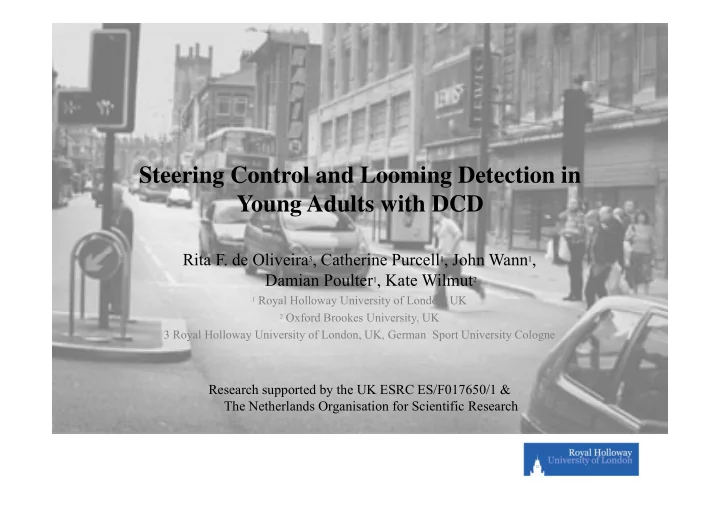

Steering Control and Looming Detection in Young Adults with DCD Y Ad lt ith DCD Rita F. de Oliveira 3 , Catherine Purcell 1 , John Wann 1 , Ri F d Oli i C h i P ll J h W Damian Poulter 1 , Kate Wilmut 2 1 Royal Holloway University of London, UK 2 Oxford Brookes University, UK 3 Royal Holloway University of London, UK, German Sport University Cologne Research supported by the UK ESRC ES/F017650/1 & The Netherlands Organisation for Scientific Research
Looming Detection in Young Adults with DCD • Looming usually indicates an approaching object • What is the perceptual ability of DCD to detect looming? p p y g • Ability to detect an approaching car is a critical roadside skill • At what speeds are young adults with DCD no longer able to detect an h d d l i h l bl d approaching car? • Measured sensitivity to looming detection in central and peripheral vision, under monocular viewing conditions
Looming Detection Thresholds for a Central Car R V = . 0.34 Looming Thresholds Θ T * TTC 2 0.32 0.30 81 0.28 0.26 0.24 deg/s) 0 22 0.22 ing Thesholds (d 0.20 mph 0.18 200ms 0.16 0.14 Loomi 196 0.12 0.10 235 0.08 N = 5 Did it get bigger? 0.06 (Null trials for FP rate) 392 0.04 0 04 0.02 0.00 <5th 5th - 15th DCD <5 th now <5 th DCD <5 th now <5 th DCD <5 th now 5 th 15 th DCD <5 th now 5 th -15 th 5 th 15 th TD mean & 95% CI TD mean & 95% CI 5 th -15 th and >15 th d >15 th • When centrally fixating, all individuals were able to detect an approaching car travelling at speeds well above those likely to be encountered in the real world (>196mph)
Looming Detection Thresholds for a Peripheral Car R V = . Θ T * TTC 2 0.50 Looming Thresholds 0.48 0.46 0.44 0.42 56 0.40 (deg/s) 0.38 62 0.36 ming Thesholds ( 69 0.34 0.32 mph 200ms 0.30 0.28 84 0.26 N = 4 Loom 0 24 0.24 0.22 0.20 Did it get bigger? Did it get bigger? 0.18 Did the car grow bigger? (Null trials for FP rate) 0.16 0 14 0.14 196 0.12 0.10 <5th 5th - 15th DCD <5 th now <5 th DCD <5 th now 5 th -15 th TD mean & 95% CI 5 th -15 th and >15 th • When not fixating directly, the speeds at which all individuals were able to detect an approaching car decreased (>56mph) compared to when individuals were directly fixating on the car (>196mph)
Looming Detection Thresholds for a Central Car with Simulated Observer Motion R V = . Θ T * TTC 2 0.52 Looming Thresholds 0.49 49 0.46 0 46 55 0.43 0.40 62 0.37 deg/s) 0.34 ing Thesholds (d 0.31 mph 0.28 200ms 0.25 0.22 107 0.19 0.19 Loomi 138 0.16 0.13 196 Did it get bigger? 0.10 235 (Null trials for FP rate) 0.07 0 04 0.04 N = 5 0.01 -0.02 <5th 5th - 15th DCD <5 th now <5 th DCD <5 th now 5 th -15 th 5 th 15 th and >15 th TD mean & 95% CI TD mean & 95% CI DCD <5 now <5 DCD <5 now 5 -15 5 th -15 th and >15 th • When in motion and detecting an approaching car centrally, overall the speeds at which individuals were able to detect an approaching car (>49mph) were much lower than when individuals were stationary and directly fixating on the car (>196mph)
Looming Detection Thresholds for a Peripheral Car with Simulated Observer Motion R V = . Θ T * TTC 2 1.90 Looming Thresholds 1.80 14 1 70 1.70 1.60 1.50 1.40 deg/s) 1.30 19 1.20 1 20 ming Thesholds ( 1.10 1.00 mph 0.90 200ms 0.80 30 0.70 0 70 Loom 38 0.60 0.50 0.40 Did it get bigger? 0.30 (Null trials for FP rate) (Null trials for FP rate) 98 98 0 20 0.20 N 3 N = 3 196 0.10 0.00 <5th 5th - 15th DCD <5 th now <5 th DCD <5 th now 5 th -15 th TD mean & 95% CI 5 th -15 th and >15 th • The ability to detect an approaching car decreased considerably for all individuals when in motion and not fixating directly on a car (~38mph) compared to when stationary and directly fixating (>196mph) • Two participants may fail to detect an approaching car travelling any faster than ~20mph T i i f il d hi lli f h 20 h
How long does it take to cross the road? • TTC fixed at 3sec – estimated length of time it takes to walk the width of a single lane – good estimate for some – good estimate for some… 7.00 Walking Speeds (normal) • … Not so good for others 6.50 6.00 5.50 5.00 Time (sec) 4.50 4.00 3.50 3.00 TTC = N=5 2.50 <5th h 5th-15th h h DCD <5 th now <5 th DCD <5 th now 5 th -15 th TD mean & 95% CI 5 th -15 th and >15 th
Conclusions • It seems that in a simple looming detection task, young adults with DCD do not have general perceptual difficulties in judging whether cars are not have general perceptual difficulties in judging whether cars are approaching • The differences found in walking speeds have implications for the execution of a safe road crossing – For example: A looming threshold that equates to being able to detect a car travelling at 60mph with 3 seconds to cross, would equate to not being able to detect a car travelling any f faster than 22mph if it takes 5 seconds to cross t th 22 h if it t k 5 d t
Recommend
More recommend